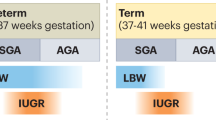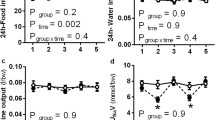Abstract
Low birth weight is associated with an increased risk of metabolic dysfunction and arterial hypertension in later life. Because of their reduced birth weight twins have been used repeatedly as a natural model to investigate prenatal programming of hypertension. To reveal an early impact of lower nephron endowment on blood pressure, we performed a longitudinal study on lambs from single, twin and triplet pregnancies. The lambs were studied from birth until adulthood, including regular blood analyses, measurements of body weight and blood pressure and post-mortem estimation of glomerular numbers. Relative weight differences between multiples and singletons at birth were −28% for twins and −44% for triplets, respectively. Some lambs showed rapid catch-up growth. Total nephron number of twins and triplets was reduced by 21 and 37% with respect to that of singletons (p < 0.01). However, multiples did not show increased blood pressure within the time frame of this study. No gender-specific effect was observed. Plasma concentrations of creatinine, urea, electrolytes or osmolality also did not differ. Our data indicate that the previously reported postnatal blood pressure differences between sheep multiples and singletons are a time-limited phenomenon. During infancy and adolescence, a reduced nephron number in sheep multiples is neither associated with increased blood pressure nor reflected by plasma parameters.




Similar content being viewed by others
Abbreviations
- IUGR:
-
intrauterine growth restriction
References
Shankaran S, Das A, Bauer CR, Bada H, Lester B, Wright L, Higgins R, Poole K (2006) Fetal origin of childhood disease: intrauterine growth restriction in term infants and risk for hypertension at 6 years of age. Arch Pediatr Adolesc Med 160:977–981
Ream M, Ray AM, Chandra R, Chikaraishi DM (2008) Early fetal hypoxia leads to growth restriction and myocardial thinning. Am J Physiol 295:R583–R595
Bubb KJ, Cock ML, Black MJ, Dodic M, Boon WM, Parkington HC, Harding R, Tare M (2007) Intrauterine growth restriction delays cardiomyocyte maturation and alters coronary artery function in the fetal sheep. J Physiol 578:871–881
Pesonen E, Johnsson J, Berg A (2006) Intimal thickness of the coronary arteries in low-birthweight infants. Acta Paediatr 95:1234–1238
Hales CN, Barker DJ, Clark PM, Cox LJ, Fall C, Osmond C, Winter PD (1991) Fetal and infant growth and impaired glucose tolerance at age 64. Br Med J 303:1019–1022
Vikse BE, Irgens LM, Leivestad T, Hallan S, Iversen BM (2008) Low birth weight increases risk for end-stage renal disease. J Am Soc Nephrol 19:151–157
Barker DJ (1995) Fetal origins of coronary heart disease. Br Med J 311:171–174
Ravelli GP, Stein ZA, Susser MW (1976) Obesity in young men after famine exposure in utero and early infancy. N Engl J Med 295:349–353
Hinchliffe SA, Sargent PH, Howard CV, Chan YF, van Velzen D (1991) Human intrauterine renal growth expressed in absolute number of glomeruli assessed by the disector method and Cavalieri principle. Lab Invest 64:777–784
Manalich R, Reyes L, Herrera M, Melendi C, Fundora I (2000) Relationship between weight at birth and the number and size of renal glomeruli in humans: a histomorphometric study. Kidney Int 58:770–773
Hughson M, Farris AB 3rd, Douglas-Denton R, Hoy WE, Bertram JF (2003) Glomerular number and size in autopsy kidneys: the relationship to birth weight. Kidney Int 63:2113–2122
Keller G, Zimmer G, Mall G, Ritz E, Amann K (2003) Nephron number in patients with primary hypertension. N Engl J Med 348:101–108
Brenner BM, Garcia DL, Anderson S (1988) Glomeruli and blood pressure. Less of one, more the other? Am J Hypertens 1:335–347
Morrison JL (2008) Sheep models of intrauterine growth restriction: fetal adaptations and consequences. Clin Exp Pharmacol Physiol 35:730–743
Vuguin PM (2007) Animal models for small for gestational age and fetal programming of adult disease. Horm Res 68:113–123
Ross MG, Desai M, Guerra C, Wang S (2005) Prenatal programming of hypernatremia and hypertension in neonatal lambs. Am J Physiol 288:R97–R103
Bains RK, Sibbons PD, Murray RD, Howard CV, Van Velzen D (1996) Stereological estimation of the absolute number of glomeruli in the kidneys of lambs. Res Vet Sci 60:122–125
Lucas SR, Costa Silva VL, Miraglia SM, Zaladek Gil F (1997) Functional and morphometric evaluation of offspring kidney after intrauterine undernutrition. Pediatr Nephrol 11:719–723
Bassan H, Trejo LL, Kariv N, Bassan M, Berger E, Fattal A, Gozes I, Harel S (2000) Experimental intrauterine growth retardation alters renal development. Pediatr Nephrol 15:192–195
Bauer R, Walter B, Bauer K, Klupsch R, Patt S, Zwiener U (2002) Intrauterine growth restriction reduces nephron number and renal excretory function in newborn piglets. Acta Physiol Scand 176:83–90
Jones SE, Nyengaard JR, Flyvbjerg A, Bilous RW, Marshall SM (2001) Birth weight has no influence on glomerular number and volume. Pediatr Nephrol 16:340–345
Mitchell EK, Louey S, Cock ML, Harding R, Black MJ (2004) Nephron endowment and filtration surface area in the kidney after growth restriction of fetal sheep. Pediatr Res 55:769–773
Wallace JM, Regnault TR, Limesand SW, Hay WW, Anthony RV (2005) Investigating the causes of low birth weight in contrasting ovine paradigms. J Physiol 565:19–26
Muhlhausler BS, McMillen IC, Rouzaud G, Findlay PA, Marrocco EM, Rhind SM, Adam CL (2004) Appetite regulatory neuropeptides are expressed in the sheep hypothalamus before birth. J Neuroendocrinol 16:502–507
Weibel ER, Gomez DM (1962) A principle for counting tissue structures on random sections. J Appl Physiol 17:343–348
Haas CS, Amann K, Schittny J, Blaser B, Müller U, Hartner A (2003) Glomerular and renal vascular structural changes in α8 integrin-deficient mice. J Am Soc Nephrol 14:2288–2296
Galan HL, Anthony RV, Rigano S, Parker TA, de Vrijer B, Ferrazzi E, Wilkening RB, Regnault TR (2005) Fetal hypertension and abnormal Doppler velocimetry in an ovine model of intrauterine growth restriction. Am J Obstet Gynecol 192:272–279
Gilbert JS, Lang AL, Grant AR, Nijland MJ (2005) Maternal nutrient restriction in sheep: hypertension and decreased nephron number in offspring at 9 months of age. J Physiol 565:137–147
Hinchliffe SA, Lynch MR, Sargent PH, Howard CV, Van Velzen D (1992) The effect of intrauterine growth retardation on the development of renal nephrons. Br J Obstet Gynaecol 99:296–301
Buzello M (2000) Comparison of two stereological methods for quantitative renal morphology: a modified fractionator and modified Weibel-Gomez method. Pathol Res Pract 196:111–117
Merlet-Benichou C, Gilbert T, Muffat-Joly M, Lelievre-Pegorier M, Leroy B (1994) Intrauterine growth retardation leads to a permanent nephron deficit in the rat. Pediatr Nephrol 8:175–180
Damadian RV, Shwayri E, Bricker NS (1965) On the existence of non-urine forming nephrons in the diseased kidney of the dog. J Lab Clin Med 65:26–39
de Geus EJ, Posthuma D, Ijzerman RG, Boomsma DI (2001) Comparing blood pressure of twins and their singleton siblings: being a twin does not affect adult blood pressure. Twin Res 4:385–391
Moritz KM, Jefferies A, Wong J, Wintour EM, Dodic M (2005) Reduced renal reserve and increased cardiac output in adult female sheep uninephrectomized as fetuses. Kidney Int 67:822–828
McMurphy RM, Stoll MR, McCubrey R (2006) Accuracy of an oscillometric blood pressure monitor during phenylephrine-induced hypertension in dogs. Am J Vet Res 67:1541–1545
Henke J, Pragst I, Zahn P, Egner B, Erhardt W (2000) Oscillometric (MEMOPRINT. S+BmedVET) vs. intra-arterial (SIEMENS SIRECUST) blood pressure measurement in anesthetized dogs. Kleintierpraxis 45:661–666
De Matteo R, Stacy V, Probyn M, Desai M, Ross M, Harding R (2008) The perinatal development of arterial pressure in sheep: effects of low birth weight due to twinning. Reprod Sci 15:66–74
Douglas-Denton RN, McNamara BJ, Hoy WE, Hughson MD, Bertram JF (2006) Does nephron number matter in the development of kidney disease? Ethn Dis 16[Suppl 2]:40–45
Nyengaard JR, Bendtsen TF (1992) Glomerular number and size in relation to age, kidney weight, and body surface in normal man. Anat Rec 232:194–201
Schreuder MF, van Wijk JA, Delemarre-van de Waal HA (2006) Intrauterine growth restriction increases blood pressure and central pulse pressure measured with telemetry in aging rats. J Hypertens 24:1337–1343
Gurnani A, Nenov VD, Taal MW, Troy JL, Mackenzie HS, Brenner BM (2000) Congenital nephron deficit (first hit) predicts increased renal injury in uninephrectomized rats (second hit). American Society of Nephrology, Renal Week, Toronto, no. A3268
Duncan RC, Bass PS, Garrett PJ, Dathan JR (1994) Weight at birth and other factors influencing progression of idiopathic membranous nephropathy. Nephrol Dial Transplant 9:875
Zidar N, Cavic MA, Kenda RB, Koselj M, Ferluga D (1998) Effect of intrauterine growth retardation on the clinical course and prognosis of IgA glomerulonephritis in children. Nephron 79:28–32
Wlodek ME, Mibus A, Tan A, Siebel AL, Owens JA, Moritz KM (2007) Normal lactational environment restores nephron endowment and prevents hypertension after placental restriction in the rat. J Am Soc Nephrol 18:1688–1696
Boubred F, Buffat C, Feuerstein JM, Daniel L, Tsimaratos M, Oliver C, Lelievre-Pegorier M, Simeoni U (2007) Effects of early postnatal hypernutrition on nephron number and long-term renal function and structure in rats. Am J Physiol Renal Physiol 293:F1944–F1949
McMillen IC, Roninson JS (2005) Developmental origins of the metabolic syndrome: prediction, plasticity, and programming. Physiol Rev 85:571–633
Acknowledgements
We thank H. Bernard, M. Klewer, M. Reutelshöfer, B. Nitzsche and S. Söllner for technical assistance and Prof. Dr. W. Rascher (Children’s Hospital Erlangen) for critical reading of the manuscript.
Statement of financial support
Part of the study was supported by the German Research Foundation (SFB 423, project Z2).
Author information
Authors and Affiliations
Corresponding author
Additional information
Anja Mühle and Christiane Mühle contributed equally to this study.
Electronic supplementary material
Supplementary figure
(PPT 213 kb)
Rights and permissions
About this article
Cite this article
Mühle, A., Mühle, C., Amann, K. et al. No juvenile arterial hypertension in sheep multiples despite reduced nephron numbers. Pediatr Nephrol 25, 1653–1661 (2010). https://doi.org/10.1007/s00467-010-1512-3
Received:
Revised:
Accepted:
Published:
Issue Date:
DOI: https://doi.org/10.1007/s00467-010-1512-3




